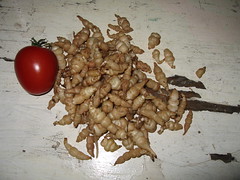
The new season’s planting will be happening soon. The garden will be hungry for new seeds the last week February / first week March. We’re going to order most of them from a very special small seed company called J.L. Hudson, and also get some additional seeds from a lovely big seed company called Seeds of Change. Seeds of Change are the people who also make organic pasta sauce and stuff, but originally they started out as a pioneering organic seed farm.
Clay and I had a good look through the seeds available at jlhudsonseeds.com and also at seedsofchange.com as these companies are owned by two couples who are my friends Sheri and David, and Howard and Nancy.
Sheri and David have lived in an old bus in the Santa Cruz mountains near Palo Alto in Northern California for the last thirty years. They have a profound knowledge of organic farming, heirlooms, the politics of food and also about local Californian growing techniques. Howard and Nancy are also totally rad and live in Northern California. Howard was Martin Luther King’s personal assistant and Nancy was on Ken Kesey’s bus. They have an amazing seed bank. Actually, I’d love to introduce these two couples to each other sometime. Maybe I’ll get to do this in the next few weeks. Hmmm…
Anyway, more importantly, Clay still has saved a lot of the following kinds of seeds from last year, either that he’s collected from our own garden’s plants going to seed, or from packets that are still here. So he’s made sure we have plenty of the following ready to go:
bell pepper
jalapeno peppers
carrots
corn (sweetcorn)
cilantro coriander
lettuce
onion
He also has a fair amount of:
pumpkin – one variety
melons – water, honeydew and cantalope
eggplant (aubergine)
radish
arugula (rocket)
sunflowers
poppies
We’ve gone through David and Sheri’s list, and this is what we like the look of in addition to Clay’s seeds:
Amaranth – Polish
Basil – dark opal; and large sweet
Bean – rattlesnake
Beet – Bull’s blood (beetroots)
Broccoli de Rapa
Burdock (arctium), Great
Cress
Celery Giant red mix
Chrysanthemum Parthenium
Corn, bloody butcher (sweetcorn)
Corn salad (mache / lamb’s lettuce)
cucumber, A & C pickling
huazontle
kale – russian red
kale – nero de philo
kohlrabi – early purple Vienna
Lavandula Stoechas (French Lavender)
okra – star of david (ladies’ fingers)
parsley – common or plain leaf
pea, dwarf grey sugar (mange touts)
pepper, Habanero
pepper, Anaheim
radish, edible-podded rat’s tail
sorrell
chives
ground cherry (psyllius)
orach, aurora
purslane, golden
quinoa, cherry vanilla
sorghum, black and white
purple goosefoot tree spinach
squash, cucuzzi caeavazzi
Swiss chard, five color silverbeet
turnip, seven top
watermelon, orangeglo
We’re also really keen to have a few more beneficial flowers, preferably ones we can eat in salads as well. So here’s a couple of collections we like the look of from Howard and Nancy’s list:
Butterfly garden seed collection
Nasturtiums mix
I am so excited about this coming season… lots of seeds to sow.





